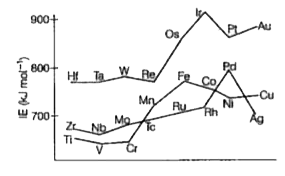(i) Write the balanced equations to represent what happens when
(a) acidified potassium permanganates reacts with hydrogen sulphide ?
(b) acidified potassium dichromate solution reacts with iron (II) solution (ionic equation) ?
(ii) The figure given below illustrates the first ionisation enthalpies of first, second and third series of transition elements.

(a) Which series amongst the first, second and third series of transition elements have the highest first ionisation enthalpy and Why ?
(b) Why there is a fall in from Cr to Mn and from Cu to Zn ? Explain. Solution in Odia
Step by step video & image solution for (i) Write the balanced equations to represent what happens when (a) acidified potassium permanganates reacts with hydrogen sulphide ? (b) acidified potassium dichromate solution reacts with iron (II) solution (ionic equation) ? (ii) The figure given below illustrates the first ionisation enthalpies of first, second and third series of transition elements. (a) Which series amongst the first, second and third series of transition elements have the highest first ionisation enthalpy and Why ? (b) Why there is a fall in IE_(2) from Cr to Mn and from Cu to Zn ? Explain. by Chemistry experts to help you in doubts & scoring excellent marks in Class 12 exams.
Updated on:21/07/2023Topper's Solved these Questions
- D-BLOCK ELEMENTSBOOK - ARIHANT PUBLICATIONCHAPTER - D-BLOCK ELEMENTSEXERCISE - Chapter practice (Short answer type II questions)
5 Videos
- COORDINATION COMPOUNDS BOOK - ARIHANT PUBLICATIONCHAPTER - COORDINATION COMPOUNDS EXERCISE - CHAPTER PRACTICE Long Answer Type Questions 7 MARKS
6 Videos
- ELECTROCHEMISTRYBOOK - ARIHANT PUBLICATIONCHAPTER - ELECTROCHEMISTRYEXERCISE - CHAPTER PRACTICE ( LONG ANSWER TYPE QUESTIONS)
3 Videos
Similar Questions
How would you account for the following ?
(i) Copper (I) is diamagnetic, whereas copper (II) is paramegnetic.
(ii) What is the common oxidation state of Cu, Ag Au ?
(iii) The d1 configuration is very unstable in ions.
View SolutionGive detailed description of CFT for different types of ligand and explain how CFT explain colour of coordination compound? Use suitable examples to explain.
View SolutionDiscuss the products obtained in electrolysis of aqueous solution of brine.
View SolutionDescribe the preparation of potassium permanganate. How does the acidified permanganate solution react with (i) iron(II) ions (ii) SO_(2) and (iii) oxalic acid? Write the ionic equations for the reactions.
View SolutionThe first elements of first, second and third transition series respectively are
View SolutionWhat happens when hydrogen sulphide is added to acidified potassium dichromate solution ?
View SolutionDescribe the preparation of potassium permanganate. How does the acidified permanganate solution react with oxalic acid ? Write the ionic equations for the reactions.
View SolutionWhat happens when hydrogen sulphide is added to acidified potassium dichromate solution ?
View SolutionDescribe the preparation of potassium permanganate. How does the acidified permanganate solution react with (i) iron(II) ions (ii) SO_(2) and (iii) oxalic acid ? Write the ionic equations for the reactions.
View Solution(a) Write balanced equations to represent what happens when (i) Cu^(2+) is treated with KI. (ii) Acidified potassium dichromate solution is reacted with iron (II) solution (ionic equation). (b) (i) The figure given below illustrates the first ionisation enthalpies of first, second and third series of transition elements. Answer the questions that follow : Which series amongst the first, second and third series of transition elements have the highest first ionisation enthalpy and why ? (ii) Separation of lanthanoid elements is difficult. Explain. (iii) Sm^(2+), Eu^(2+) and Yb^(2+) ions in solution are good reducing agents but an aqueous solution of Ce^(4+) is a good oxidising agent. Why?
View SolutionDescribe the preparation of potassium permanganate. How doe the acidified permanganate solution react with (i) iron (II) ions (ii) SO2 and (iii) oxalic acid? Write the ionic equations for the reactions.
View SolutionWhich elements in first transition series has maximum third ionization enthalpy?
View SolutionWrite balanced equations for reacting ions to represent the action of acidified potassium dichromate solution on Potassium iodide solution
View SolutionWrite balanced equations for reacting ions to represent the action of acidified potassium dichromate solution on Acidified ferrous sulphate solution.
View SolutionGive balanced chemical equations for what happens when acidified potassium dichromate solution reacts with : Ferrous sulphate solution
View SolutionGive balanced chemical equations for what happens when acidified potassium dichromate solution reacts with : Hydrogen sulphide
View Solution
